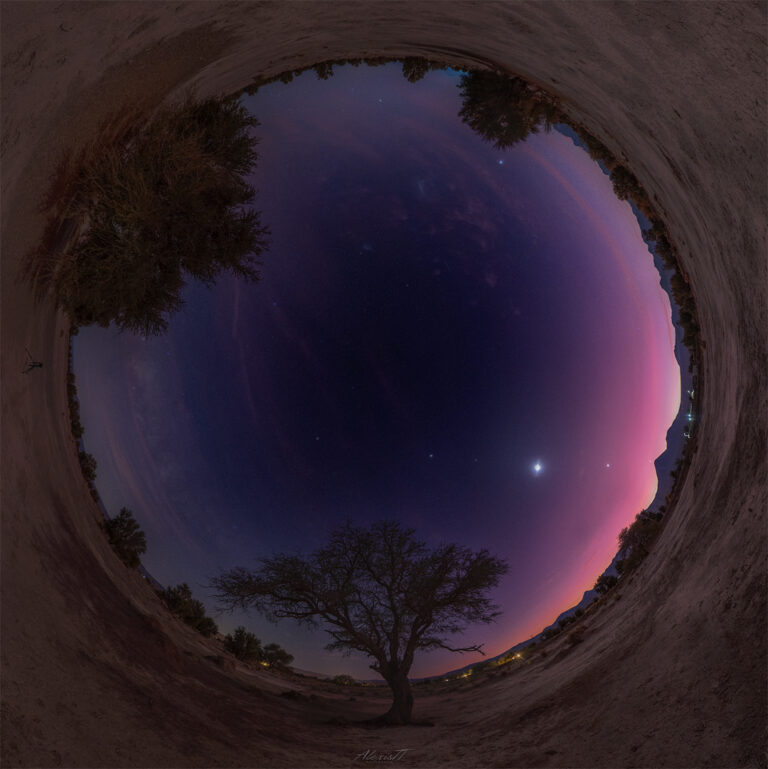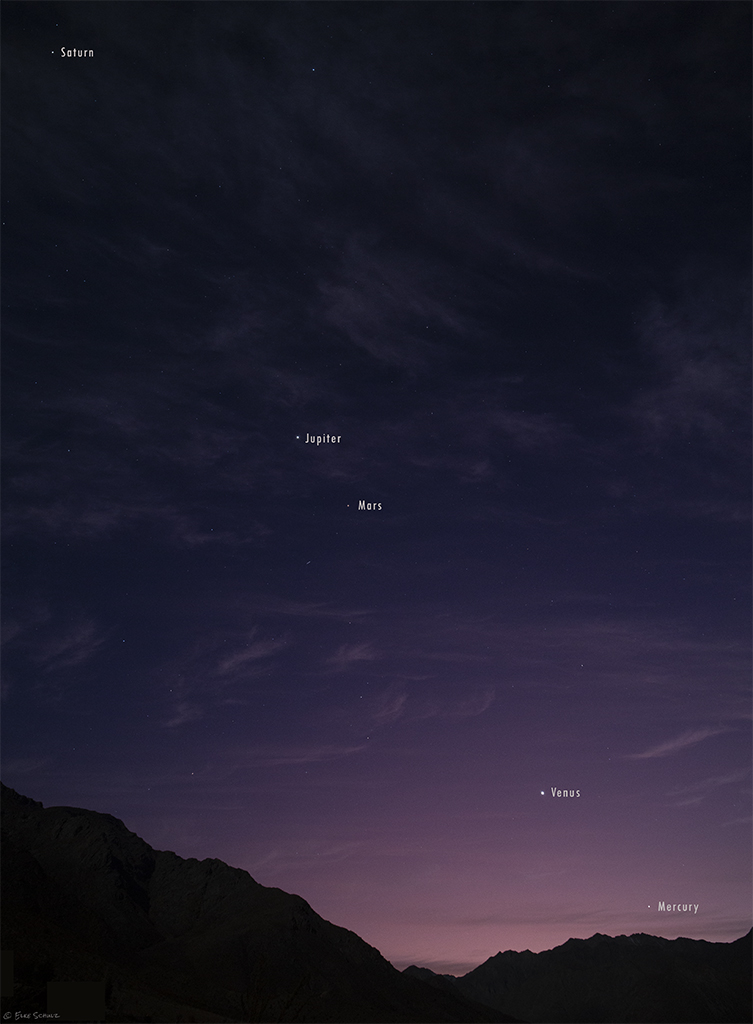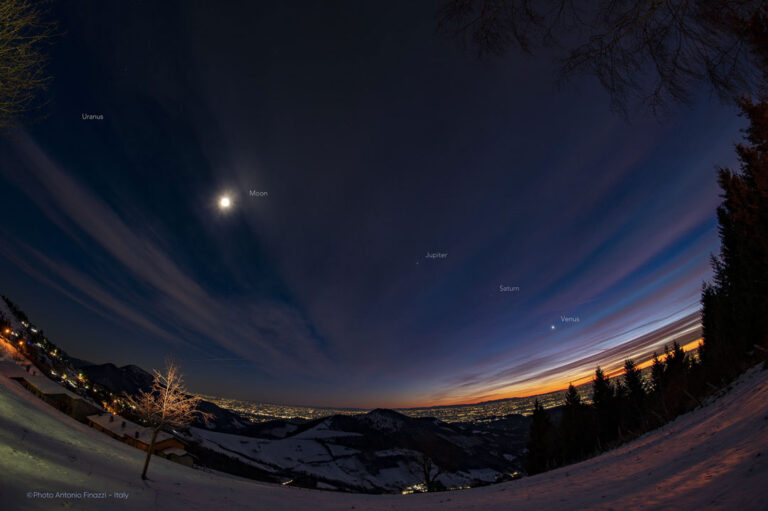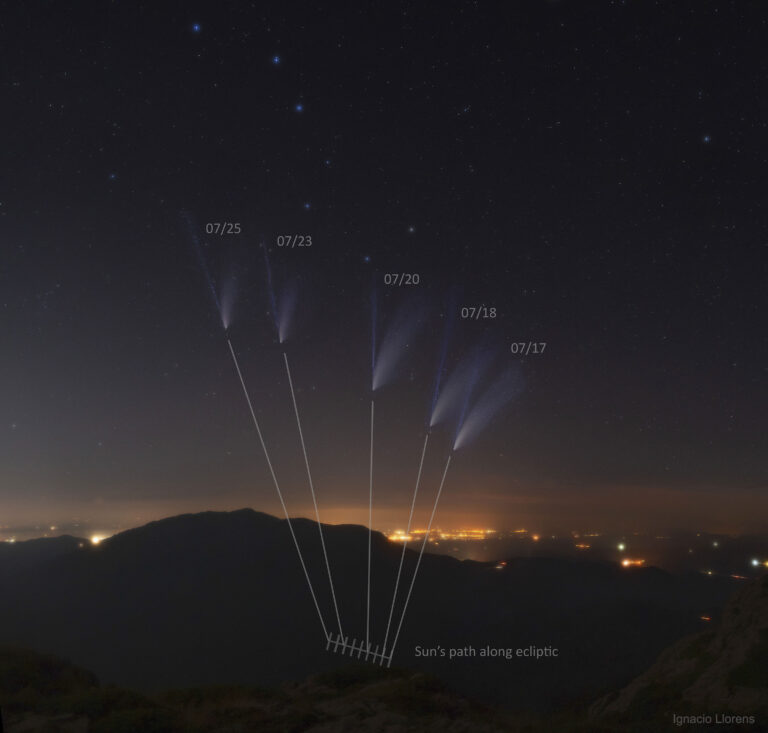夏至的满月
See Explanation. Clicking on the picture will download the highest resolution version available.
请参阅说明。单击图片将下载可用的最高分辨率版本。

See Explanation. Clicking on the picture will download the highest resolution version available.
请参阅说明。单击图片将下载可用的最高分辨率版本。

2022年6月29日 Solar System Family Portrait Image Credit & Copyright: Alexis Trigo Explanation: Yes, but have you ever seen all of the planets at once? A rare roll-call of planets has been occurring in the morning sky for much of June. The featured fisheye all-sky image, taken a few mornings ago near the town of San Pedro de Atacama in Chile, caught not only the entire planet parade, but the Moon between Mars and Venus. In order, left to right along the ecliptic plane, members of this Solar System family portrait are Earth, Saturn, Neptune, Jupiter, Mars, Uranus, Venus, Mercury, and Earth. To emphasize their locations, Neptune and Uranus have been artificially enhanced. The volcano just below Mercury is Licancabur. In July, Mercury will move into…

2022年6月17日 Good Morning Planets from Chile Image Credit & Copyright: Elke Schulz (Daniel Verschatse Observatory) Explanation: On June 15, innermost planet Mercury had wandered about as far from the Sun as it ever gets in planet Earth’s sky. Near the eastern horizon just before sunrise it stands over distant Andes mountain peaks in this predawn snapshot from the valley of Rio Hurtado in Chile. June’s other morning planets are arrayed above it, as all the naked-eye planets of the Solar System stretch in a line along the ecliptic in the single wide-field view. Tilted toward the north, the Solar System’s ecliptic plane arcs steeply through southern hemisphere skies. Northern hemisphere early morning risers will see the lineup of planets along the ecliptic at a shallower…

2021年12月19日 Planetary Alignment over Italy Image Credit & Copyright: Antonio Finazzi Explanation: It is not a coincidence that planets line up. That’s because all of the planets orbit the Sun in (nearly) a single sheet called the plane of the ecliptic. When viewed from inside that plane — as Earth dwellers are likely to do — the planets all appear confined to a single band. It is a coincidence, though, when three of the brightest planets all appear in nearly the same direction. Such a coincidence was captured earlier this month. Featured above (right to left), Venus, Saturn, and Jupiter were all imaged together in a line just after sunset, from the San Fermo Hills, Bergamo, Italy. Joining the alignment are Earth’s Moon, and the…

2021年03月11日 Zodiacal Light and Mars Image Credit & Copyright: Joshua Rhoades Explanation: Just after sunset on March 7, a faint band of light still reaches above the western horizon in this serene, rural Illinois, night skyscape. Taken from an old farmstead, the luminous glow is zodiacal light, prominent in the west after sunset during planet Earth’s northern hemisphere spring. On that clear evening the band of zodiacal light seems to engulf bright yellowish Mars and the Pleiades star cluster. Their close conjunction is in the starry sky above the old barn’s roof. Zodiacal light is sunlight scattered by interplanetary dust particles that lie near the Solar System’s ecliptic plane. Of course all the Solar System’s planets orbit near the plane of the ecliptic, within the…

2020年8月12日 The Shifting Tails of Comet NEOWISE Image Credit & Copyright: Ignacio Llorens Explanation: Keep your eye on the ion tail of Comet NEOWISE. A tale of this tail is the trail of the Earth. As with all comets, the blue ion tail always points away from the Sun. But as Comet C/2020 F3 (NEOWISE) rounded our Sun, its ion tail pointed in slightly different directions. This is because between 2020 July 17 and July 25 when the featured images were taken, the Earth moved noticeably in its orbit around the Sun. But the Earth’s motion made the Sun appear to shift in the sky. So even though you can’t see the Sun directly in the featured image(s), the directions of the ion tails reveal…